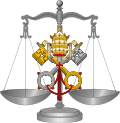 |
| Part of a series on the |
| Canon law of the Catholic Church |
|---|
| |
The Catholic Church has excommunicated some of its adherents throughout its existence for various reasons, including heresy, schism, and disobedience to the Church or its teachings.
Contents
- 1st century
- 2nd century
- 3rd century
- 4th century
- 5th century
- 6th century
- 7th century
- 8th century
- 9th century
- 10th century
- 11th century
- 12th century
- 13th century
- 14th century
- 15th century
- 16th century
- 17th century
- 18th century
- 19th century
- 20th century
- 21st century
- See also
- References
- External links
In Roman Catholic canon law, excommunication is a censure and thus a "medicinal penalty" intended to invite the person to change behavior or attitude that incurred the penalty, repent, and return to full communion. [1] Excommunication severs one from communion with the Church; excommunicated Catholics are forbidden from receiving any sacrament and refused a Catholic burial, but are still bound by canonical obligations such as attending Mass or fasting seasonally. Excommunicated Catholics, however, are barred from receiving the Eucharist or from taking an active part in the liturgy (reading, bringing the offerings, etc.). [2]
Henry IV, Holy Roman Emperor, with 5 separate excommunications from 3 different popes, carries the distinction of publicly being the most excommunicated individual. In this list below there are two popes (Honorius I and Leo I) and six Catholic saints (Leo I, Athanasius, Columba, Arialdo, Joan of Arc, Mary Mackillop) who were issued an excommunication by a church authority.
This list only includes excommunications acknowledged or imposed by a decree of the pope or a bishop in communion with him. Latae sententiae excommunications, those that automatically affect classes of people (members of certain associations or those who perform actions such as directly violating the seal of confession [3] or carrying out an abortion), [3] are not listed unless confirmed by a bishop or ecclesiastical tribunal with respect to certain individuals.







